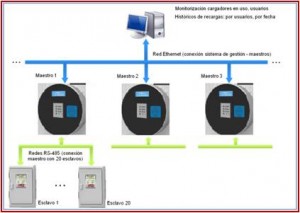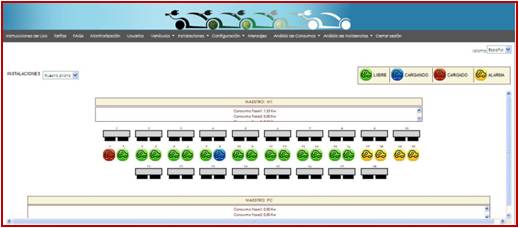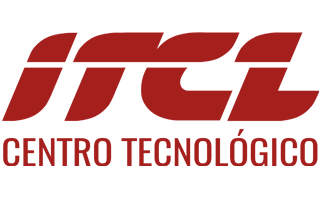Charging points placed in public environments have special requirements.
Their installation in a garage, community parking or public car park also means specific requirements: contracted power might not be enough; there may be several entrances to the facility, etc.

Master-Slave Configuration
ITCL has developed an Intelligent Electric Vehicle Charging System.
The system has master-slave architecture and comprises a set of charging points that are managed by a master device, where charge price or battery percentage is selected.
The global system topology is an Ethernet network between PC and master devices and a RS-485 network between master and salve devices.

Charging Station Architecture in public environments
Each slave device enables the management of a MODE3 or MODE1 socket outlet.
Master devices are connected to a server where specific software monitors and controls the charge states of every slave in the network, as well as the network status access operations that can be performed by the manager or by the users by means of a Web Service or Text Messages. The server also performs pattern recognition and energy distribution tasks.
The master device implements the user interface by means of a keyboard, a LCD display and a proximity card reading/writing device.
Technical specifications
Master features:
- Access and payment by means of proximity cards
- User information shown in Display
- Impact resistant numeric keyboard
- RFID reader: ISO14443A
- RFID frequency: 13,56 MHz
Slave features:
- Output Voltage: 230/400 VAC
- Input Voltage: 50 Hz
- MODO3 socket: type 2 as required by IEC 62196
- MODO1 socket: Schuko socket outlet up to 16A
- Energy meter: built-in meter
- Protections: Residual Current Device and Thermal Magnetic Circuit Breaker
- IP protection IP45
- Dimensions: 340x460x160

Monitoring the status of recharging vehicles
CE MARKING
This product has been designed in compliance with the specific requirements of European Directives 2006/95/CE (Low Voltage Directive) and 2004/108/CE (Electromagnetic Compatibility)
STANDARDS
- UNE-EN 61851-22:2002
- UNE-EN 20324:1993 + MOD.2000
- EN 60529:1991 ERR.:1993 + A1:2000
- UNE-EN 55022:2008, UNE-EN 61000-3-3:2009
- UNE-EN 61000-3-2:2006 + A1:2010 + A2:2010
- UNE-EN 61000-4-11:2005, UNE-EN 61000-4-4:2005
- UNE-EN 61000-4-5:2007, UNE-EN 61000-4-3:2007
- UNE-EN 61000-6-3:2007, UNE-EN 61000-6-1:2007

